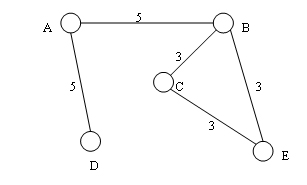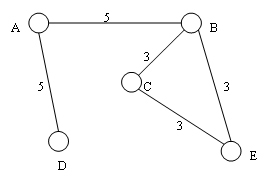Graph coloring-based wireless frequency allocation working method
A technology of wireless frequency and working method, applied in the field of information communication, can solve the problems such as the inability to guarantee the optimal solution, the inability of the frequency allocation algorithm to apply to the wireless ad hoc network, and the long time period.
- Summary
- Abstract
- Description
- Claims
- Application Information
AI Technical Summary
Problems solved by technology
Method used
Image
Examples
Embodiment Construction
[0022] V k The coloring algorithm for can be given by the following formula:
[0023] Order C k = C 0
[0024] C k = C k +1, |C k -C l | k = C k ,|C k -C l | ≥ Wj (l=1..n and l ≠ k, Wj is V k and V l sides between).
[0025]
[0026] For example, if there are five wireless subnets A, B, C, D, and E below, the subnets are abstracted into vertices, and several edges with weights are generated between the subnets according to the frequency interval rules. The relationship between nets and subnets is abstracted as an undirected graph, as shown in the accompanying drawings figure 1 Shown:
[0027] The algorithm selects the vertex B with the highest degree from the graph, assigns the default initial color number 1, and then colors the adjacent vertices of vertex B in turn. The color numbers for A, C, and E are: 6, 4, 7, and finally Color vertex D as 11. After coloring, the algorithm selects f6, f1, f4, f11, and f7 from the frequency table {f1, f2, ..., fn (n>1)}...
PUM
 Login to View More
Login to View More Abstract
Description
Claims
Application Information
 Login to View More
Login to View More - R&D
- Intellectual Property
- Life Sciences
- Materials
- Tech Scout
- Unparalleled Data Quality
- Higher Quality Content
- 60% Fewer Hallucinations
Browse by: Latest US Patents, China's latest patents, Technical Efficacy Thesaurus, Application Domain, Technology Topic, Popular Technical Reports.
© 2025 PatSnap. All rights reserved.Legal|Privacy policy|Modern Slavery Act Transparency Statement|Sitemap|About US| Contact US: help@patsnap.com


